#italian Marble In Ahmedabad
Explore tagged Tumblr posts
Text
Which Marble is Good for Home? A Comprehensive Guide
Choosing the right marble for your home can be a daunting task, given the variety of options available. From its natural elegance to durability, marble has been a timeless choice for flooring, countertops, and wall cladding in homes. If you're considering marble for your home, especially Italian marble in Ahmedabad, you're in for a treat. Italian marble is renowned for its superior quality, but there's more to know before making your decision. We will explore various types of marble and how they can enhance different areas of your home.
1. Why Choose Marble for Your Home?
Marble has been admired for centuries for its natural beauty and luxurious appeal. Its smooth texture, wide range of colors, and unique veining patterns make it a favorite among homeowners and designers alike. Here are a few reasons why marble is an excellent choice for home interiors:
Aesthetic Appeal: Marble adds elegance to any room, making spaces feel more luxurious.
Durability: Marble is strong and can withstand years of use if properly maintained.
Variety: There are various types of marble to choose from, each with different colors and veining patterns.
Versatility: Marble can be used for floors, countertops, bathroom tiles, and even as a decorative element for walls and furniture.
2. Types of Marble for Homes
When selecting marble, it’s essential to understand the different types available and their characteristics. Here are some popular types of marble you can consider:
2.1 Italian Marble
Italian marble is widely recognized for its luxurious look and is often used in high-end homes and hotels. It comes in various colors, with shades of white being the most popular. Some of the most famous Italian marbles include:
Carrara Marble: Known for its white to light gray appearance, Carrara marble is subtle and versatile. It’s a great choice for minimalist designs.
Statuario Marble: This type of marble has more pronounced veining, with striking white and gray tones. It’s ideal for making a bold statement in any room.
Calacatta Marble: With thicker, more dramatic veining, Calacatta marble is often associated with luxury. It’s perfect for creating a standout feature wall or a lavish countertop.
2.2 Indian Marble
Indian marble is also highly sought after due to its affordability and durability. Some of the popular varieties include:
Makrana Marble: Known for its use in the construction of the Taj Mahal, Makrana marble is a premium Indian marble. It’s highly durable and available in white and off-white shades.
Ambaji Marble: Sourced from Gujarat, Ambaji marble is famous for its pristine white color and is commonly used in flooring and wall cladding.
Rajnagar Marble: This marble is available in a wide range of colors, including white, green, and pink, making it suitable for various design styles.
2.3 Other Imported Marble
Apart from Italian marble, there are several other types of imported marble that offer a unique look:
Turkish Marble: Known for its soft, creamy hues and delicate veining, Turkish marble is perfect for creating a warm, inviting space.
Greek Marble: Greek marble, particularly from the island of Paros, is renowned for its pure white color and high luminosity, making it a premium choice for homes.
3. Where to Use Marble in Your Home?
Marble can be used in various areas of your home to enhance its beauty and functionality. Here are some popular applications:
3.1 Flooring
Marble flooring adds a sense of grandeur to your home. Whether you opt for Italian marble in Ahmedabad or Indian marble, the glossy finish and natural veining will elevate the aesthetic of any room. Marble floors are best suited for living rooms, hallways, and entryways, where their beauty can be showcased.
3.2 Countertops
Marble countertops are a popular choice for kitchens and bathrooms. The smooth surface makes it easy to clean, and the unique veining adds a luxurious touch to your cooking or grooming space. For high-end kitchens, Calacatta or Statuario marble are often chosen due to their bold veining.
3.3 Bathroom Tiles
Marble tiles in the bathroom create a spa-like ambiance. The natural stone’s water-resistant properties make it ideal for bathroom flooring, shower walls, or vanity tops. Using white marble in smaller bathrooms can make the space feel more open and airy.
3.4 Wall Cladding and Decor
For a more dramatic look, consider using marble for wall cladding in living rooms or dining areas. You can also incorporate marble into your home decor through marble-topped tables, mantels, or decorative pieces.
4. Maintenance of Marble
While marble is a durable material, it does require regular care to maintain its beauty. Here are some tips for keeping your marble in top condition:
Seal the Surface: Marble is porous and can absorb liquids, leading to stains. Sealing the surface every few years can help protect it from spills.
Use Mild Cleaners: Avoid using harsh chemicals on marble as they can cause etching. Instead, use a mild detergent and water to clean the surface.
Protect from Scratches: Marble can be prone to scratches, especially on countertops. Use trivets under hot pots and pans, and avoid dragging heavy objects across marble floors.
Wipe Spills Immediately: Since marble can stain easily, it’s important to wipe up spills, especially those from acidic substances like wine or citrus juice, as soon as they occur.
5. Choosing the Right Marble Supplier
Selecting the right supplier is crucial for ensuring you get high-quality marble. In Ahmedabad, there are several reputed suppliers of Italian marble who can provide a variety of options to suit your home’s design. When choosing a supplier, look for:
Reputation: Check reviews and ask for recommendations to ensure the supplier is trustworthy.
Quality: Examine the quality of the marble, including its finish, thickness, and veining.
Price: Compare prices from different suppliers to ensure you’re getting a fair deal without compromising on quality.
Conclusion
Marble is a timeless material that can elevate the elegance of your home, whether you opt for the luxurious Italian marble in Ahmedabad or durable Indian marble. Understanding the different types of marble and their best uses can help you make an informed decision that suits both your aesthetic and functional needs. With proper care and maintenance, marble can enhance your home’s beauty for years to come.

0 notes
Text
Discover Elegance and Comfort with TriGroup's 3 BHK Luxurious Flats in Ahmedabad
Ahmedabad, a vibrant city that blends rich historical heritage with modern lifestyle needs, is experiencing a burgeoning demand for residential spaces that cater to the sophisticated tastes of its residents. Recognizing this trend, TriGroup proudly offers an array of 3 BHK luxurious flats in Ahmedabad, designed meticulously to provide an unmatched living experience.
Unparalleled Luxury and Design:
At TriGroup, we believe that luxury is in each detail. Our 3 BHK flats are the epitome of luxury and comfort, with spacious layouts that allow for ample natural light and ventilation. Each home features modern aesthetics and is equipped with state-of-the-art amenities. From Italian marble flooring to modular kitchens equipped with the latest appliances, every corner speaks of quality and sophistication.
Strategic Location:
Location is paramount in real estate, and our luxurious flats are strategically located in some of the most sought-after areas in Ahmedabad. Whether it's proximity to business districts, educational institutions, healthcare facilities, or entertainment zones, TriGroup ensures that you are well-connected yet comfortably secluded from the hustle and bustle of the city life.
Amenities That Enrich Your Lifestyle:
TriGroup’s 3 BHK flats come with an array of amenities that cater to all age groups and diverse preferences:
Swimming Pool: Dive into the crystal-clear waters of our swimming pool designed for relaxation and fitness.
Fitness Center: Stay fit and healthy with our state-of-the-art gymnasium equipped with the latest fitness technology.
Children’s Play Area: A safe and vibrant space for kids to play and interact.
Clubhouse: A stylish space to socialize with other residents or host private events.
24/7 Security: With advanced security features, including surveillance cameras and security personnel, your safety is our top priority.
Sustainable Living:In line with global trends, our flats are constructed with a focus on sustainability. Energy-efficient systems, rainwater harvesting, and waste management practices are integral parts of our design philosophy, ensuring that your living space is both beautiful and responsible.
Why Choose TriGroup? Choosing TriGroup means opting for a lifestyle that combines luxury, convenience, and sustainability. Our commitment to quality and customer satisfaction stands us apart, and our track record of successful projects ensures that your investment is secure and profitable.
Conclusion: With TriGroup’s 3 BHK luxurious flats in Ahmedabad, experience a blend of luxury, comfort, and convenience that transforms everyday living into a celebration of life’s finer aspects. We invite you to visit our properties and envision the life that awaits you in one of the most beautiful residential offerings in Ahmedabad.
1 note
·
View note
Text
4 Bhk Flat For Sale In H1 Unique Park, Satellite, Ahmedabad
This is a low rise residential project with four floors in total and the ground. There are nine apartments in total. Each floor consists of just two flats, offering you ample opportunity for privacy. It is in close proximity to Nandi Hills as well as Satyagraha Chavni.
Each apartment has a spacious carpet area of 3800 sq. Ft. The 4 BHK apartments have spacious and well-planned bedrooms, opulent living rooms, and a spacious, open balcony. The view from the balcony is soothing to the eyes. The greenery all around will bring solace to your tired mind. No more car parking issues! You can park up to 3 cars here.
You will simply love the wooden flooring as well as Italian Marble flooring of these apartments. Not to forget the luxurious bathroom fixtures that add up to the aesthetics of each apartment.
One of the biggest concerns that residents often express is about their safety. H1 makes sure that there are no safety issues at all. It offers a robust security system to the inhabitants. With huge, strong entry and exit gates, security guards, and the latest technology backing up the security of the entire area, there is nothing to be worried about. You can leave your house for a vacation without having to fuss about the safety and security in your absence. The place is absolutely safe for old couples too who stay on their own. Apart from this, there are a whole lot of amenities and facilities available to you. In case you are planning to shift from your old house, try H1. You will definitely love the place.
#4bhkapartments#4bhkluxuryapartments#3bhkapartments#2bhkflats#2bhk for sale#3bhkflats#3bhkhomes#3bhkluxuryapartments#3bhkresidences#4 bhk bungalow
0 notes
Text
Polar Grey Marble
Polar Grey Marble is a kind of grey marble quarried in Italy . This stone is especially good for Building stone,countertops, sinks, monuments, pool coping, sills, ornamental stone, interior, exterior, wall, floor , paving and other design projects. It also called Tundra Grey Marble,Blue Tundra Marble,Tundra Grey Blue Marble. Polar Grey Marble can be processed into Honed, Aged, Polished, Sawn Cut,…

View On WordPress
#architecture#bhutra polar grey marble#italian#italian in kishangarh#italian in raipur#italian in ranchi#italian Marble In#italian Marble In Agartala#italian Marble In Agra#italian Marble In Ahmedabad#italian Marble In Ajmer#italian Marble In Akola#italian Marble In Aligarh#italian Marble In Allahabad#italian Marble In Ambattur#italian Marble In Amravati#italian Marble In Amritsar#italian Marble In Asansol#italian Marble In Aurangabad#Italian Marble In Bangalore#italian Marble In Bareily#italian Marble In Belgaum#italian Marble In Bellary#italian Marble In Bhagalpur#italian Marble In Bhavnagar#italian Marble In Bhilai#italian Marble In Bhiwandi#italian Marble In Bhopal#italian Marble In Bhubaneswar#italian Marble In Bikaner
0 notes
Text

Tiles fitting services in Gujarat, Rajasthan, Maharashtra. Rajasthani people are well known for their ability to install tiles, marble, granite with quality finishing.
Rajasthani experienced tile professionals are now available on line.
#tilefloor#flooring#marble#architecture#bedroom#bathroom#tilework#granite#italian marble#exterior#interior#vadodara#surat#ahmedabad#mumbai
0 notes
Text
Urban Frame House - Designed by Prashant Parmar Architect & Interior Designer

4 BHK Bungalow in Ahmedabad Evolved Harmoniously With Nature! The client had a simple and clear brief of 4 BHK Bungalow and was seeking a lifestyle that evolved harmoniously between man and nature. They wanted the house to have a connection with the garden, plenty of natural light, and lively interiors.

As one enters the house, the built form reveals its framed facade closely. This concept of frames is introduced with the intent to maintain the privacy of the user. The planning allows for integrating a linear parking area. Since the house shares a common wall with an adjoining bungalow on the south, a beautiful garden has been provided in the north. A hierarchy of three frames creates an interesting mass of volumes.

The ground floor is an exciting and cozy space with prudent openings. The first frame marks a refreshing entry to the garden as well as to the house with double-height volume, with fresh views of the garden lots of natural light and air. One lands into a vestibule that gives a glimpse of the spaces leading to the drawing-room.

The drawing room opens to the views of the garden and has a swift connection and a nature-inspired theme. The dining and kitchen space are placed opposite to each yet allows significant visual connections with the main entry and drawing room as well. What I love most about this house, is a stunning family sitting with a huge void space above connecting the ground floor to the highest ceiling of the house.

With an artificial vertical garden in its backdrop, this space becomes even more appealing and colorful. This volume creates a drama of light and shadows throughout the day across the interiors with the triple-height window.
The parents’ bedroom is drawn towards the south and has its own garden with pergola. The journey to the upper level happens through the circulation facilities like the staircase and a lift, placed towards the south. The first floor is a brightly lit space with the natural light striking the passages that lead to the master and son’s bedroom. The passage overlooks the vertical garden wall the family sitting below. The master bedroom expresses the warmth of the wood and the combination of a bronze mirror with white MCM cladding material and its significantly large size allows visual connections with the ground floor entrance and the garden below. An elevated garden facing west has been provided on the first level, being enclosed directly by the highest façade frame, it becomes a double heightened garden. The son’s bedroom towards the south displays a blend of dark earthen elements. On the second floor, a guest bedroom and a compact leisure room are placed adjoining to a vast elevated party lawn. This terrace garden gives the users a chance to get closer to the ultimate height of the uppermost frame. The materiality of the house is vibrant in every space. Combination of stone, wood, Italian marble for flooring across the house, and the contemporary furniture pieces, add luxury and comfort to the spaces. This Urban Frame House is a unique combination of spatial planning extensive spaces and expressive lights that helped visualize the dreams of our client. PROJECT FACT FILE: Name: Urban Frame House Location: Paldi, Ahmedabad. Plot Area: 3,600 sq.ft. Built-up Area: 5,000 sq.ft. Start Year: 2017 Completion Year: 2019 Amid a dense residential society of Ahmedabad, this residence evolves as an interesting mass of three volumes. The structure follows a hierarchy of frames which are inscribed in a varied mix of materials and textures. This gives the facade a sturdy look amid the colony of conventional and simple old residential structures. Each framed volume of this facade improvises the journey through the house by allowing the strategical segregation of spaces. About us Prashant Parmar Architect established his firm in 2000. Shayona Consultant is one of the most established architectural and interior practices in Ahmedabad. We offer Innovative Design Solutions, Executed over 1000 projects with national and international experience of over 19 years in the field of Architecture and Interior. Prashant Parmar Architect is a distinguished name among the Top Architects in Gujarat and Prashant Parmar Architect is a prominent and the Best Architects & Interior Designer in Gujarat. We offer Residential, Hospital, Office, Industrial & Commercial Architecture & Interior Design Services in Ahmedabad, Gujarat, India. To explore our projects & unique work, visit our website: www.prashantparmar.com Happy Exploring from Shayona Consultant - Helping You Visualize Your Dream! Stay connected with us: Facebook | Instagram | Twitter | Linkedin | Youtube
#UrbanFrameHouse#UrbanHouseDesign#4BHKBungalowDesign#ModernArchitects#ModernHouseDesign#ArchitectsInGujarat#InteriorDesignerGujarat#PrashantParmarArchitect
1 note
·
View note
Photo

The Green Axis | Hitesh Mistry and Associates (@hiteshmistry_associates) | Ahmedabad We had a perfect square plot to play with, placing the the house on the center of plot led us to two axis on the site with good amount of space in front and back, the plan was worked out in detail according to these axis. While planning the house according to axis which made the spaces face the views. The design of the house is an extrovert one, which makes each room/space connected to the outdoor with a view in all four directions. The #house plan has two vertical and horizontal axis which connects with all the rooms on both the sides- it has 5 spacious bedrooms, alone with formal and a casual living room, 5 master bathrooms with connected dressings and many outdoor seating areas. Having kids living a hostel life they wanted the house to be felt like a vacation home for them which made us include a pool and home theater in the house. The central theme of the house is Modern contemporary. Material pallets include- cortern steel, Italian marbles, exposed concrete, brass. #Architecture, #interior and #landscape is done by the firm Hitesh Mistry and Associates, thus is synchronized well with each other. Project Name : The Green Axis Firm Name : Hitesh Mistry and Associates (@hiteshmistry_associates) Principal Designer : Mr. Hitesh Mistry Design Team : Saloni Patel, Bhavesh Gajjar Plot Size : 10,604 Sq. Feet Engineering : In house Completion Year : 2019 Location : Ahmedabad, Gujarat Photography Credit : Tathya Macwan (@tathya.clicks), Phx India (@phxindia) . #landscapephotography #architecturephotography #interiorphotography #tathyaclicks #phxindia — view on Instagram https://ift.tt/3EJNZ9w
0 notes
Text
10 Residential must-have amenities in Ahmedabad
10 Residential must-have amenities in Ahmedabad
Ahmedabad is exponentially growing with high connectivity and accessibility brought about by the growing infrastructure, Ahmedabad too offers now a fast pace life which could be stressful and demanding for full time working professionals, creative heads or diligent homemakers. Thus residences with luxuries and social amenities in the locality could bring in great comfort to discerning homebuyers. Most potential buyers aim to cut down on the chaos and bustle of the city and reside in serene, green spaces with best of luxuries at their disposal.
The presence of luxurious amenities and a prime locality certainly influences a potential buyer’s decision. Though, the plethora of indoor/outdoor amenities such as swimming pool, a gym, or a park, clubhouse may increase maintenance and add to the home owner’s overall monthly expense, yet many buyers nowadays ask for such amenities, while buying a project.
Home buyers today are vigilant enough to make their own list of essential, not required amenities and do a comparative cost analysis of selected projects, before paying up for something that they may never use in their lifetime.
The list of amenities that are broadly recognized as essential or discretionary for the home buyers of Ahmedabad are:
Essential amenities:
- Car parking
- Security services
- Water supply
- Elevators
- Power backup
- 24-hour maintenance
Car parking facility is one of the most demanded facilities in Ahmedabad’s new projects. The second most important factor is its connectivity to important business centers via rail and road. Home seekers want to ensure continuous supply of water and electricity and earthquake-resistant apartments. These features are a complete mandate for projects as they are the most basic of the facilities required by buyers. However, if they wish to lure the discerning crowd they will have to offer a lot more luxurious amenities.
- Discretionary amenities:
- Walking/Jogging track
- Play area
- Club house
- Swimming pool
- Gym
- Rooftop garden
- Open deck
- Sky lounge
- Spa and salon
- Concierge services
- Restaurants
- Party hall
- Temple and religious activity place
- Cinema hall
- Wi-Fi connectivity
The Discretionary amenities have however, become as primary as the basic in the . The amenities for physical fitness and play area for kids is the most essential for a peaceful quantum lifestyle.
Mumbai undoubtedly is one of the most sought-after destinations for luxury and semi-luxury apartments in recent years. Thus, to allure potential buyers a host of modern features such as modular kitchens, Italian marble, wooden flooring, swimming pools, recreational rooftop amenities and smart home technology is being offered by the top builders in Ahmedabad such as Arvind Smartspaces. These facilities definitely add that extra zing of comfort and classiness to your lifestyle.
Each of Arvind Smart spaces is masterpieces with the most conducive features and amenities. They have redefined luxury for their clients by utilizing the most skilled of the business. Renowned names of the industry are a part of this ingenious team and have successfully manifested their excellence in these tastefully designed homes.
The residents of Ahmedabad have a sophisticated taste this also reflects in their choice of amenities, too. Features including Jacuzzi, multi-level parking, landscaped gardens, and electronic surveillance units are common in Ahmedabad’s high-end property listings like the Arvind Smartspaces and they are certainly worth it the price you pay.
0 notes
Text
Looking for a Credible Car Carrier Service in Ahmedabad?

Many groups are specialized in car transport services In Ahmedabad and are working particularly in this service. But some people who are shifting their residence prefer driving by themselves or a company offering a low budget, hence bearing the higher future loss. As riding on yourself is riskier and exhausting. Also, choosing a company without prior checking can cause corruption. Therefore, selecting a perfect company based on a few points will help you in getting a reliable deal. Some indicators will certainly aid you in finding the best car carrier service in Ahmedabad.
Keys to reach the best car transport company in Ahmedabad:
Some hints will benefit you in your shifting process and will prevent any fraud. Those indicators are as follows,
● Government registered
The company you would be deciding for your car carrier services in Ahmedabad shall be registered. Therefore, you must ask for the GST number and all the proof regarding its registration. A non-registered business can do a conspiracy in the future, hence creating trouble in your movement procedure.
● Rate of service
Examining the price of the service being provided by the business is also important. It is an influential tip that you must follow while choosing a car transport company in Ahmedabad. Multiple companies are proposing different rates to customers. Therefore, checking the best possible rates is mandatory so that no cheating occurs.
● Company transparency
The business with which you would be dealing for your service shall keep everything transparent. There shall not be any confidential charges put on you. You must go through the documents before signing them and paying for the service.
● Shipment span
The time taken by any company is different and is calculated as per the distance of the shipment. Thus, including the duration of transportation in paperwork, is crucial. Hence, before paying any amount, you should check the time of your car carrier as well.
● Get set, go!
Ultimately, you can keep your car ready for shipment if you completely satisfy yourself with the corporation. Since you are delivering your car to the firm, you must clean it and scan for dents, if it has you must improve it. After that, transmit your car to the firm.
Best ten companies contributing successful car carrier service in Ahmedabad:
We found these ten top companies running profitable car carrier services on the ground analysis through our tips. Those dealing organizations are:
● Vikash Car Carrier
● Neelkanth Cargo Packers and Movers
● Trusted Packers and Movers
● Universal Cargo Packers Movers
● Indian Car Carrier
● CTL Car Carrier
● Top 10 Packers Movers
● Bright Magic Italian Marble Paste
● Shiva Global Relocation Pvt Ltd.
● Anytime Car Carrier Service
These firms are working closely into car carrier service in Ahmedabad. Hence making all customers satisfied with their assistance. These businesses have been enlisted based on the arrows mentioned above. Thus, you shall follow the same to have a great carrier service.
Prefer the best car transport company in Ahmedabad to safely ship your car!
#car carrier service in Ahmedabad#car transport company in Ahmedabad#car transport services In Ahmedabad#car transportation services#Car Shifting In Ahmedabad#car shipping services ahmedabad
0 notes
Text
Top 5 Famous Colors Of Marble For Your Home Flooring
When it comes to enhancing the beauty and elegance of your home, marble flooring has always been a timeless and sophisticated choice. Marble not only exudes luxury, but its durability and unique patterns make it a preferred option for many homeowners. Among various types, Italian marble holds a prestigious position due to its high quality and unmatched aesthetic appeal. If you're searching for the perfect marble to adorn your home, you might want to explore the collection of Italian marble in Ahmedabad, where you can find a variety of stunning marble colors. Below, we’ll explore the top 5 famous colors of marble that can elevate your home’s interior.
1. Carrara White Marble
Carrara White Marble is one of the most iconic and widely used marbles in the world. Originating from the Carrara region of Italy, this marble has been used in sculptures and architecture for centuries. Its clean, soft white background with delicate grey veining makes it a versatile choice for flooring and other interior applications.
Why choose Carrara White Marble?
Timeless elegance: The subtle gray veins and the soft white color give your home a classic and sophisticated look.
Versatility: It complements various design styles, from contemporary to traditional.
Brightness: White marble helps in brightening up spaces, making rooms look larger and more open.
This marble works beautifully in bathrooms, kitchens, and living rooms, creating a serene and clean atmosphere.
2. Calacatta Gold Marble
If you’re looking for something more dramatic and luxurious, Calacatta Gold Marble is an exceptional choice. Known for its distinctive thick veins in gold and grey, Calacatta Gold is a premium type of Italian marble that radiates opulence.
What makes Calacatta Gold Marble special?
Luxurious appearance: The gold veins give it a luxurious feel, ideal for high-end interiors.
Unique patterns: Each slab of Calacatta marble is unique, meaning no two pieces will look the same, adding to its exclusivity.
Bold statement: It works well as a statement flooring piece, particularly in large areas like living rooms and foyers.
This marble is perfect for those who want to add a touch of grandeur to their home.
3. Emperador Brown Marble
For those who prefer earthy tones and a warmer ambiance, Emperador Brown Marble is an excellent choice. This marble is known for its rich brown tones with lighter veins of cream or gold, giving it a warm, welcoming feel.
Advantages of Emperador Brown Marble:
Warm aesthetics: The brown hues create a cozy and inviting atmosphere, ideal for living rooms and dining areas.
Durability: Like other marbles, Emperador Brown is strong and durable, making it a practical option for high-traffic areas.
Versatile design: It pairs well with both traditional and modern decor, making it a flexible option for various interior styles.
This marble is often used in combination with lighter-colored stones to create contrast and depth in home interiors.
4. Statuario Marble
Statuario Marble is another well-known Italian marble that is famous for its rich white background and dramatic dark grey veins. It’s a high-end marble, often used in prestigious projects and luxury homes.
Why Statuario Marble is a great choice:
Stunning visual appeal: The strong grey veining on a crisp white background creates a striking contrast, making it a stunning flooring option.
Prestigious choice: Statuario Marble is used in some of the world’s most luxurious spaces, making it synonymous with sophistication and elegance.
Brightens spaces: Like Carrara White, Statuario also helps in reflecting light, creating an airy and open feel in any room.
This marble is ideal for large spaces like entrance halls or living rooms where you want to make an impressive visual impact.
5. Green Marble
Green Marble is an exotic and eye-catching option for homeowners who want to bring nature indoors. The rich green color combined with subtle white veins makes this marble a beautiful and refreshing choice for flooring.
Benefits of Green Marble:
Unique look: The green color adds a touch of nature and serenity to your interiors, creating a calming environment.
Durability: Like other types of marble, green marble is extremely durable and can withstand wear and tear, making it suitable for areas like kitchens and bathrooms.
Refreshing ambiance: The cool green tones provide a refreshing ambiance, perfect for creating a relaxed and tranquil space.
Green Marble is perfect for those who want something different and wish to bring a natural, earthy feel to their homes.
Choosing the Right Marble for Your Home
When selecting marble for your home flooring, it's essential to consider not only the aesthetic appeal but also the practicality of the stone in different areas. Each of these top 5 marble colors offers distinct advantages, from the timeless appeal of Carrara White to the bold luxury of Calacatta Gold. Whether you want to create a serene, warm, or opulent atmosphere, there is a marble type that will suit your design needs.
Tips for Maintaining Marble Flooring:
Regular cleaning: Marble should be cleaned regularly with a mild, pH-balanced cleaner to prevent etching and staining.
Sealing: Since marble is a porous material, it’s important to seal it properly to protect it from moisture and stains.
Avoid harsh chemicals: Avoid using acidic cleaners like vinegar or lemon, which can damage the surface of the marble.
By selecting the right marble and following these maintenance tips, you can ensure that your marble flooring remains beautiful and timeless for years to come.
Conclusion
Marble flooring offers a luxurious and timeless option for homeowners who want to elevate their interior spaces. With a wide range of colors and patterns to choose from, including the classic white Carrara, the opulent Calacatta Gold, the warm Emperador Brown, the elegant Statuario, and the refreshing Green Marble, there’s a perfect option for every style. For those in search of high-quality Italian marble in Ahmedabad, you’ll find a stunning selection that can transform your home into a haven of elegance and style.
0 notes
Video
tumblr
4 BHK Luxurious Flats SG Highway - Ahmedabad from 4000* sq. ft. Biggest Size in Ahmedabad Rs 2.48*Cr Onwards. with 40+ world class amenities. 7 BHK lavish Sky Villa duplex spread over 15,000 sq. ft. 11 feet Height Wooden Flooring in bed rooms Italian Marble in living room Ac's in all rooms Home Automatiom system and many more @ Shree Balaji Wind Park, Ahmedabad. Pay 20%, rest with easy EMI. Ready to move-in! GST Free! Book Now: 8690 853 853 Visit: https://bit.ly/2RPDji2
0 notes
Text
Polar Grey Marble
Polar Grey Marble is a kind of grey marble quarried in Italy . This stone is especially good for Building stone,countertops, sinks, monuments, pool coping, sills, ornamental stone, interior, exterior, wall, floor , paving and other design projects. It also called Tundra Grey Marble,Blue Tundra Marble,Tundra Grey Blue Marble. Polar Grey Marble can be processed into Honed, Aged, Polished, Sawn Cut,…

View On WordPress
#architecture#bhutra polar grey marble#italian#italian in kishangarh#italian in raipur#italian in ranchi#italian Marble In#italian Marble In Agartala#italian Marble In Agra#italian Marble In Ahmedabad#italian Marble In Ajmer#italian Marble In Akola#italian Marble In Aligarh#italian Marble In Allahabad#italian Marble In Ambattur#italian Marble In Amravati#italian Marble In Amritsar#italian Marble In Asansol#italian Marble In Aurangabad#Italian Marble In Bangalore#italian Marble In Bareily#italian Marble In Belgaum#italian Marble In Bellary#italian Marble In Bhagalpur#italian Marble In Bhavnagar#italian Marble In Bhilai#italian Marble In Bhiwandi#italian Marble In Bhopal#italian Marble In Bhubaneswar#italian Marble In Bikaner
0 notes
Text
Hiring tile Contractors is very easy now.
Call Rajasthani Tile professionals directly online for high quality tiles, granite, marble fitting services in Gujarat, Rajasthan, Maharashtra.
#interior #construction #exterior #bathroom #flooring #marble #design #granite #realty #maharashtra #Gujarat #rajasthan #vadodara #jaipur #mumbai #jalgaon #surat #Ahmedabad #bhavnagar #pune
https://www.rajasthantilecontractors.com/

0 notes
Text
We Two Dervishes: Istanbul Diaries
If you do not wish to read the whole article but are interested in a typical itinerary and tips, skip to the last section. Important tips are highlighted in Bold also.
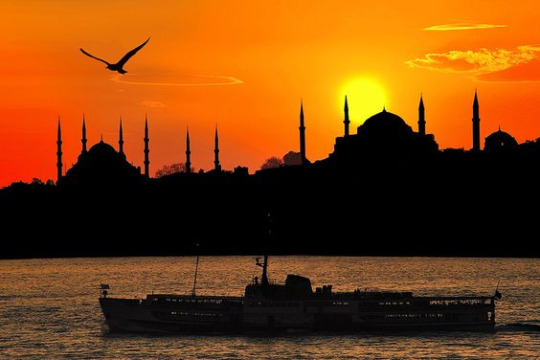
Courtesy: Mehmet Gören (Pintrest)
Pins and Needles
To think that this trip almost never happened.
ProTip: Take the visa rules very seriously. The spirit doesn’t matter, the letter absolutely does. Also, never overestimate Consulates and Visa centres, if they say it will take 10 days, take it to mean that it will take 11 days at least and prepare accordingly.
4 days until the trip, no visa in hand, sleepless nights, continuously refreshing the VFS website for any change in the status of arrival of Visa from Mumbai to Ahmedabad, estimating time it takes for courier services to deliver a package from Mumbai to Ahmedabad and constantly flitting between self reassurance and sick-in-the-stomach worry that visa won’t arrive on time. If only we had been a day early, the situation where a small delay could fully derail the trip I have wanted to take for a long time would not have precipitated, and all the preparation, from ordering The Museum of Innocence, to vividly imagining/dreaming of being there would sink in front of our eyes. To say nothing of the monetary loss, because we had booked non-refundable flights.
The visa arrived two and a half hours before our departure to Mumbai. The VFS staff weren’t sure when the damn thing would come, so we just decided to camp out in front of the visa centre and wait for the Blue Dart mini-truck. Fortunately they were expecting a delivery in the evening, and they were kind enough to give our visas to us after their working hours (Visa Centres and Consulates are strict about their working hours. Fervently so). I am not sure when the last time I had a tsunami of relief wash over was. The package soon arrived and we heard the guard talking amongst themselves about arrival of Japanese, American, and to our good fortune, Turkish. We ran to Forex centre close by, requesting them on phone to stay open for a little while (thankfully, they wanted our business) and managed to buy a modest sum of 230 Euros, because that’s all the Euros they had.
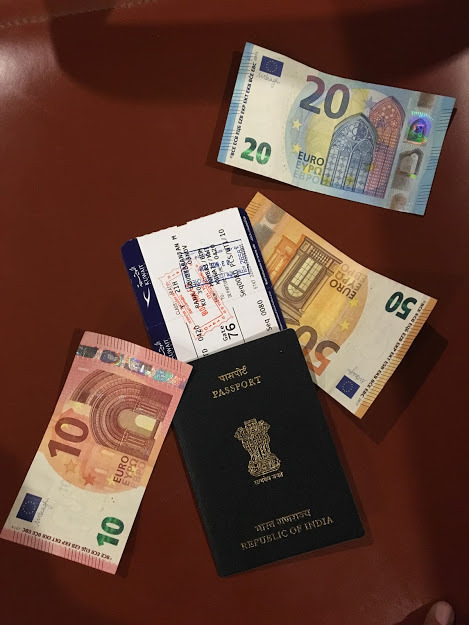
Sigh of Relief
Battlefield
I would like to argue that the first country out of my own that I have stepped on is Turkey and that layovers don’t count, because boy Kuwait City was disappointing. The only fascinating thing that one can see in the darkness before dawn break are the fires in the oil fields. Kuwait City, especially the area around the airport looks like an empty abandoned desert, and it should because it is far from the actual Kuwait City. If you look at the map of Kuwait, you will be struck by the featurelessness of the country, apart from the dense network of roads around a small tip that is Kuwait City. The airliner from Mumbai had nice food (as airplane foods go), and a courteous and diverse staff: You had an Indian, an Arabian, a Caucasian, an African, and an Asian. The Cinema and TV selection were average, but the movies were heavily censored. Even words like ‘Hell’ were muted, and absolutely no scenes of intimacy, even those that would be demure by Bollywood standards!
The airport has 2 terminals. The old one receives flights from Mumbai, and the new modern terminal services to Istanbul. The ground staff, or the lack of them is particularly pain in the ass. It was 6a.m and passengers were to be transferred to new terminal, and the staff was scrambling to get the security officer and the bus driver to service the passengers, causing delays. This worried me a bit during the onward flight, because the return flight, we had a layover of meagre 1 hour 25 min. (And my fears came true. The return flight departed half an hour late from Istanbul, because of a fuel leakage which stalled our take-off and put us right at the end of the queue. We had to scramble to get to put flight to Mumbai, because guess what, it rained that day. In a desert.) The Security check was especially very adamant on checking each and every item in the baggage. In fact, they didn’t even allow us the toothpaste, so we had to go foul mouthed all the way till our hotel at Istanbul!
The ground staff of the airport comprised mostly of, you guessed it, immigrants. And of those, most of them are South Asians. And of those, most of them appeared Malayalis, fulfilling the Gulf dream as their counterparts elsewhere. You can easily get by with Hindi around the airport at least. And the toilets do not have urinals! This complies with the personal law prescribed in Islam. The washrooms at Istanbul do have the urinals though.
KWI of course was a battlefield in the Battle of Kuwait International Airport, a significant battle of the Gulf War between US and allies and occupying Iraq led by Saddam Hussein.
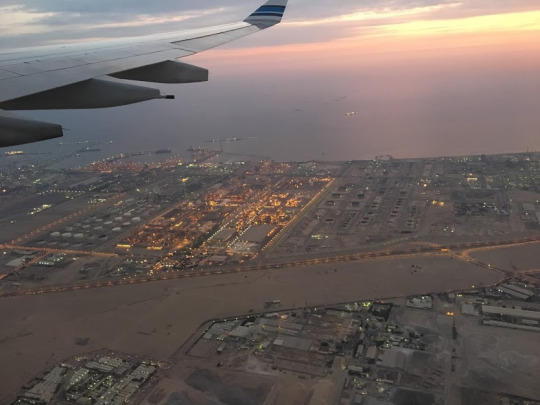
Where Airlift was Set
Why Istanbul?
Because Istanbul is magical. A place where the streets whisper to you the tales the glory and doom, rise and fall; ascension and declination of emperors, sultans and revolutionaries; not unlike the undulating terrain it occupies. The place where the East meets West, the great continents and civilisations of Asia and Europe face off across a narrow waterbody that also connects North with the South. To see Istanbul, to understand Istanbul is to understand the history of the culture and civilisation of a major part of the world, in fact the world itself. Devout muslims, avid history buffs, Europhiles, party creatures- they will all find in the ruins and the glory of the city what they are looking for.
Istanbul is a time capsule, a place where time is laid out in space like a spread out deck of cards.
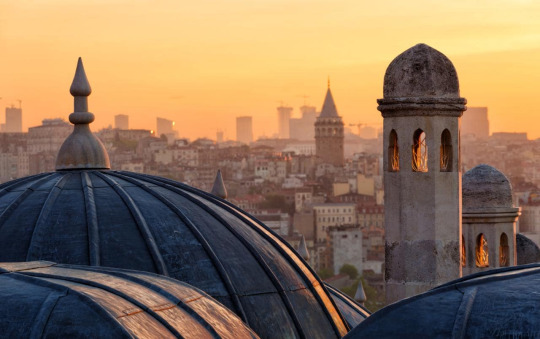
A stock photo
It’s a Church! It’s a Mosque! It’s Museum!
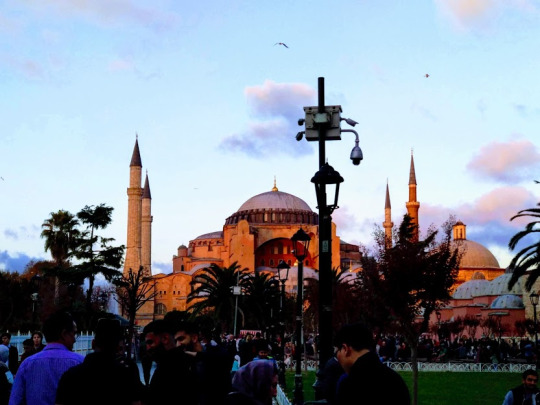
My fascination with Ayasofya or Hagia Sophia, or the magnitude of it, is somewhat a puzzle to me. I do not know why I have been entranced by this beautiful, beautiful Eastern Roman/Ottoman marvel. I know for certain it began when I first read about it in Netfundu magazine in my school days. Netfundu was a kiddie magazine complimentary during the heydays of Indian Airlines, the domestic govt. operated carrier before it was disastrously merged with Air India. Maybe it was about the name or it was about the architecture, but it never escaped my imagination after that. It is an important must see for travellers visiting Istanbul, and is one of those things that do not disappoint, despite a small part of it being covered with scaffolding for renovation.
Where else will you see Jesus, Mary, Allah and Muhammad together in one single place?
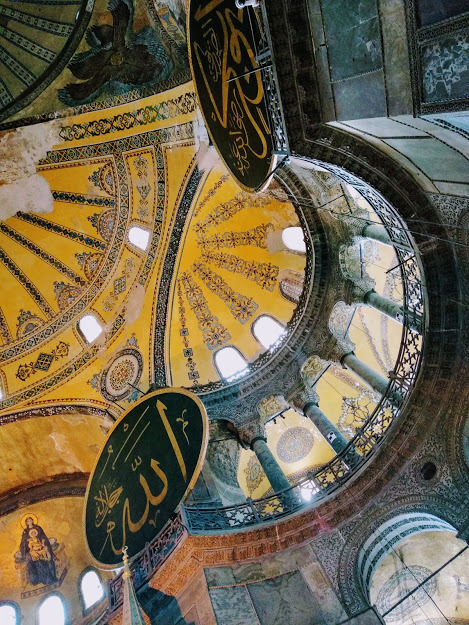
After capturing Constantinople, the Ottomans removed or plastered over mosaics and images of Jesus, Mary, Constantine, Justinian and various other Byzantine Emperors from the walls, as Islam prohibits representation of human figures because no one but Allah is allowed to create. This is the reason why Topkapı, Blue Mosque and all the other Ottoman palaces (Not Dolmabahçe; we will come to that) are covered with exquisite tiles and carpets as decoration and not paintings, as a guide we shamelessly eavesdropped at Blue Mosque tried to explain his captive (and paying) group. Orhan Pamuk’s masterpiece My Name Is Red, the book that put in me the fascination to visit Istanbul, devotes a considerable portion of his book discussing this aspect of Islamic philosophy, of prohibition of creating realistic portraits, thereby challenging Allah. This attitude is reflected even now, with reports of Modern day Saudi Arabia destroying historical artifacts around Mecca to build hotels. Or ISIS destroying Palmyra. Sultan Mehmed II, the conqueror (Fatih, which now renders its name to the UNESCO heritage historic area of the old city. Note similarity to the Hindustani word ‘Fateh’) ordered a massacre of Roman residents, then asked for muslim immigrants to settle Constantinople, and converted Hagia Sophia, the ‘Church of Wisdom’, into a mosque.
The images that we see of Jesus, Mary and the other kings were restored by Swiss-Italians Fossati Brothers, entrusted with the task of renovating the mosque by Sultan Abdulmecid to renovate Hagia Sophia. Many old, precious mosaics are still lurking under the ones plastered over.
The church that stands today is actually the third iteration. Two were destroyed by fire and riots before Emperor Justinian built the third in 537 AD. The ruins of the 2nd Ayasofya found in excavations are put to display outside the building. The White marbles and sheeps will catch your eye.
Once you go inside, you will see hung on the wall a proclamation by Mustafa Kemal Ataturk, the father of the modern Republic, and his cabinet secularising the mosque by converting it into the museum. This makes one realise that Hagia Sophia houses inside itself the history and the character of the city of Istanbul, and of Turkey itself. From Romans, to Ottomans, to the new secular republic, Ayasofya is a time capsule, having stubbornly endured earthquakes and conquests and the hyper-secularisation. It feels as if the monument now stands before you and whispers to you the story of Istanbul and indeed of civilisation it has witnessed. For those with a sense of history, Ayasofya cannot be anything but fascinating, and there is no building like it anywhere.
As for the grandeur of the interior, I will let the images do the talking.
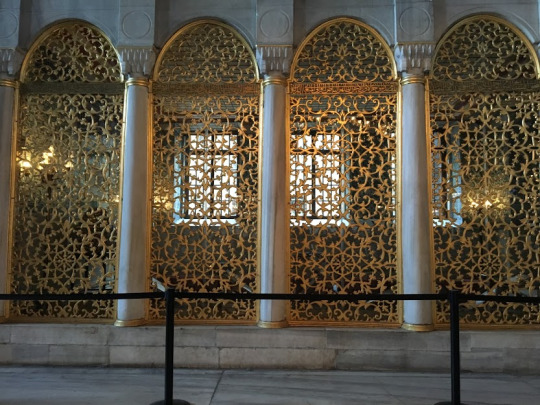
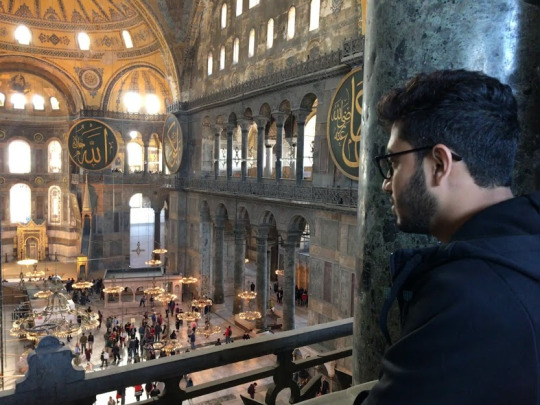
Pro Tip: Get the ticket for Ayasofya, Topkapı and Archaeology museum together for 135TL instead of getting them individually. All are worth a visit.
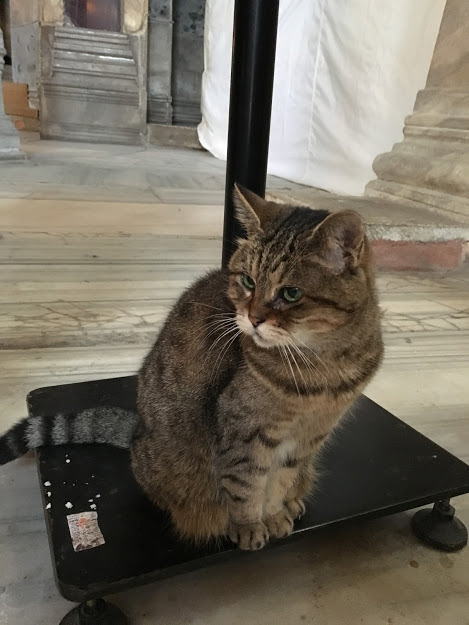
Hey kitty kitty! Istanbul’s cats, like her Sultans, are fat!
Blue Mosque, the second jewel of Sultanahmet sitting right next to Ayasofya, was unfortunately under renovation, so a lot of it was covered. We managed to witness some of the famed Iznik tiling anyway. Note how this and all of the other mosques in Istanbul, and in fact the rest of the Turkey, are influenced by Ayasofya. One interesting thing we noted was that the instructions outside the gate urges the visitors to refrain from, among other things, kissing inside the Mosque. Helpful tip.
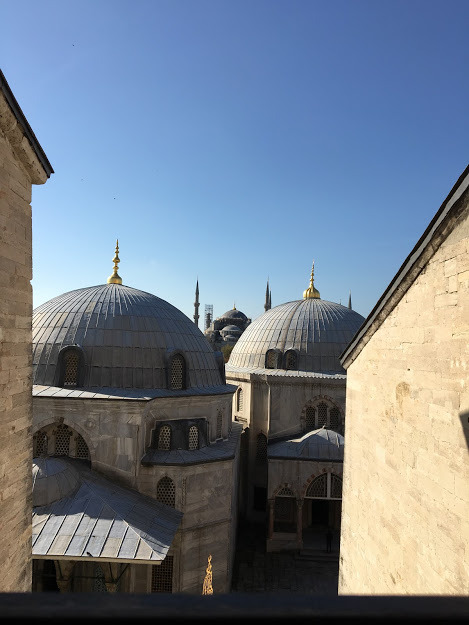
Blue Mosque seen from Ayasofya window
The fame of Blue Mosque, or Sultanahmet Mosque (Camii, pronounced Jami. Similarity with Hindustani to be noted) somewhat eclipses that of Suleymaniye Mosque, named after Suleiman the Magnificent, the ruler during the golden ages of Ottoman Empire. That should not dissuade anybody from paying it a visit, because it is indeed at par with its more famous counterpart, and lot less crowded. We obviously enjoyed it more because of the restoration at Blue Mosque. The minimalism and unassuming nature of the interior complements the huge size of the interior. Free pamphlets and small books explaining Islam are distributed inside, and we helped ourselves to some.
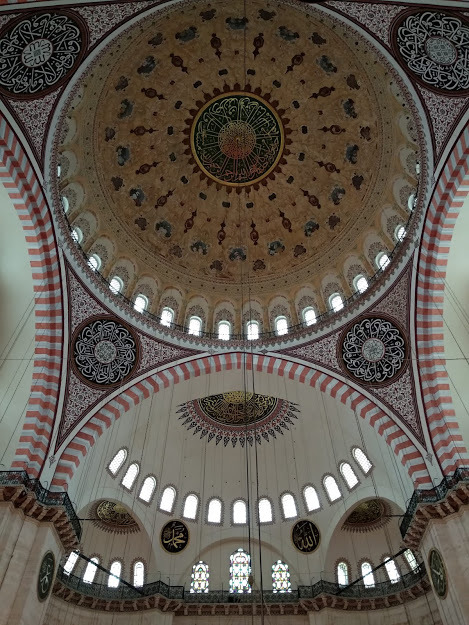
Walls of Suleymaniye Mosque
Steamy
At night, we decided to try one of those famous Turkish baths, or Hamam. Most hotels will know who to call for their customers, and Mihriban hooked us up with Gedikpasa Hamam, somewhere in the mesh of cobblestoned streets, touristy hotels and heritage structures that is Sultanahmet. It was pretty cool because I had read that it was one of the oldest Hamams that still existed, probably the oldest, as it was established by the eponymous Pasha in 1453. Turns out, they have a pick-up from and drop-to service, and a big van pulled up in front of our hotel. We climbed in, and off it went, cruising confidently like it had done before umpteen times through the narrow lines and sloped terrains to an old establishment with a facade that might render it inconspicuous among the densely packed shops and restaurants, but on entering you will find yourself amongst a relic, a living history.
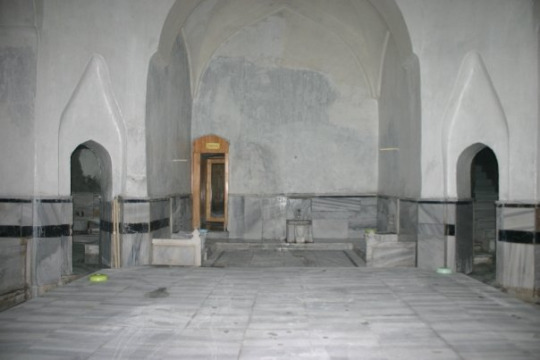
You are told about the various services by the receptionist, like you can use the Hamam yourself for about 80 TL, or you could get a foam bath and massage from a staff for 120 TL. For a few more bucks, you could get a honey massage, but we didn’t fancy it that much. You are led to a room where you keep your belongings and change into a towel,and tie the key on your wrist. After washing oneself, one enters the steam chamber.
The steam chamber, the actual shvitz, has marble flooring and plastered ceiling, which is dome shaped, and an aura of antiquity that makes you realise that you are sharing a public bath with 550 years of history. This feeling, perhaps encapsulates the entire spirit of Sultanahmet and Istanbul itself. The warmth of hot steam soothes you from the cold of outside, and the steam feels cleansing, although one’s breathing becomes a tad bit belaboured due to the temperature and steam content of the air. Soumya rushes in and tells excitedly that there was a guy who just took of his towel in the corridor without a care!
And soon somebody came to take out ours. An old gentleman, whose name I couldn’t catch because of the language and accent barrier asked me to sit in a corner, near a tap with a basin below it created out of a parapet of diminutive height. He started rubbing me with the foam HARD, as if trying to wipe away my epidermis. Tiny, black-brown, spindle shaped dirt started to roll away as he pulled back his hands during the violent rubbing, leaving a pink skin it its wake. He did this on the limbs, and then in the central raised floor, made me lie down, and removed my towel. For the briefest moment, I was fully in my birthday suit, lathered up it was far, far from being sensual. I also managed to catch another gentleman getting the same rubbing down. Only he was upside-down, with towel covering the valley between the hills, making it perfectly clear what awaited me. The awkward agony ended when the gentleman rearranged my towel to closely cover the unmentionables, and begin the intense massaging that flitted around the boundary of pain and pleasure. Then he overturned me and proceeded with my back and sciatica. I was able to muffle my screams of agony/ecstacy, but Soumya was crying (moaning?) out loud in response to his masseuse’s strong hands.
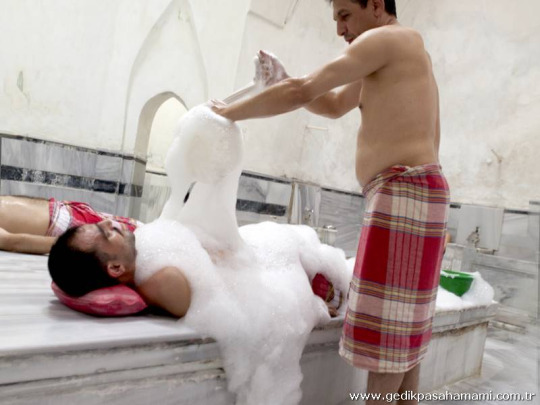
A file photo from the Hamam website
At the end of it, he took me back to the bathing place and cleaned off the foam. Shook hands with me and said something with the word 50. Either he was talking about his age, or about the tip (Which would have been too much, almost half the cost of the whole service).
After one is done with steam and massage, one can wash it off and cool it in a green pool in a cave like niche, finishing off a wholly tranquilizing experience in a high.
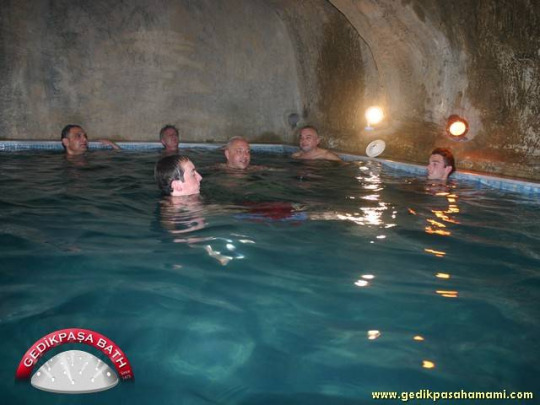
The Tale of Two Palaces
Topkapı Palace is actually a Royal complex, with multiple courtyards having buildings and rooms that served various royal functions: schooling, receiving diplomats, circumcising princes, meeting general public. Standard stuff. The highlight of Topkapı though is the one room where they don’t allow photography: The room that contains artefacts that are believed to be personal belongings of prophets in like Moses, David, Abraham, and Muhammad. It also has sacred relics from Kaaba including the door for the Kaaba. The caliphate passed on to Ottomans after their conquest of Mecca in 1517, and they brought in many holy relics from Mecca to be stored in Topkapı, including dentures and hair of Prophet Muhammad.
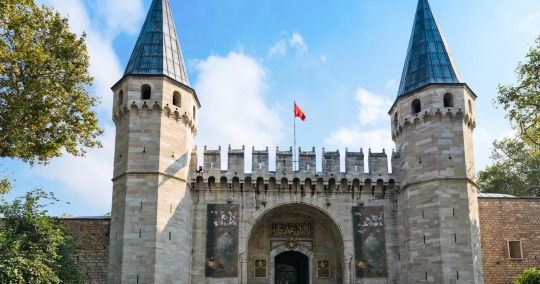
Courtesy: getyourguide.com
One gets a peak of the lives of Sultans in the empire from visiting the harem. Harem is the private part of the palace, and is where Sultan, his countless mistresses and the head of the household, the Valide Sultan or Sultan’s widowed mother lived. There is a separate ticket for Harems in all palaces, about 30 TL. A package deal may cost less, so take it. Since any given Sultan with his countless harems is bound to have many children, all equally entitled to the throne, almost every succession involves fratricide i.e. potential successor killing off all of his brothers to establish his succession. After Mehmed II, as I learned later through fascinating Wikipedia (back home) and Quora articles, the practice was even codified and considered a rite of passage! As I looked at the corridors, the walls, the exquisite washrooms and the magnificent rooms, I could not help but wonder of all the drama and palace intrigues that would have taken place in the harems with their shehzades, Valides, concubines, wives,eunuchs, soldiers and assassins maybe?

Panorama of the entrance

Famed Iznik tile works
One of the most remarkable dome interiors in the beautiful white dome of the library. Mesmerised, we spent longer than usual staring at this stunning dome. As mentioned earlier, the main decorations in the palaces and mosques are accomplished using tiles and carpets since representation was not allowed. There are 1-2 paintings in the administrative chambers though, that too miniatures.

The Library dome
Topkapı is located at the tip of Fatih area overlooking stunning views of Bosphorus. This makes slightly overpriced restaurant at Topkapı, Konyali, worth a try, because as you can see, it makes for a kickass picture.
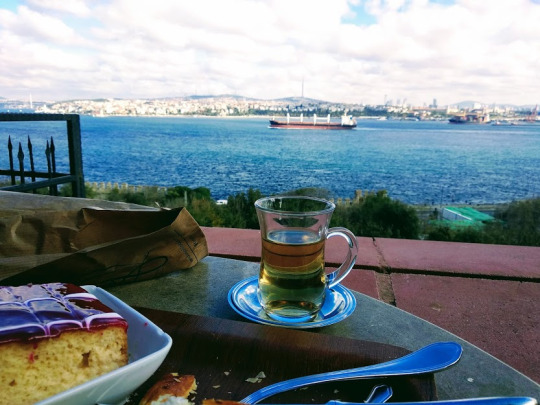
Bliss atop @ Konyali restaurant
For all its glory and its size, Topkapı is still somewhat...humble. Of course, it is very difficult a claim with your gates, size, views and separate rooms for shehzade’s circumcision, but if you compare it with a typical European palace, like say The Hermitage of St. Petersburg (of which I have only gone through a coffee table book), the palace complex is unassuming and not grandiose.
This realisation strikes you only when you visit the Dolmabahçe Palace. Sultan Abdulmecid I had a somewhat similar idea, and decided that he deserved a palace just like his European peers elsewhere, even if it costed the empire a quarter of its tax revenues that year. The financial hole that the palace made contributed to the empire’s nickname as ‘the sick man of Europe’.But what a hole! The tourists with a 90TL combo ticket (Muzekart, in case any overplanned enthusiastic tourist has taken, is not accepted here) would certainly say it was worth it.
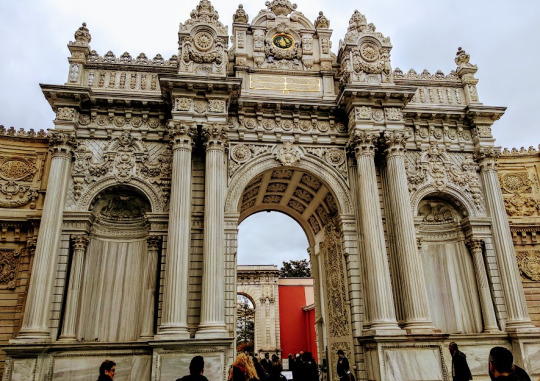
The European style imposing entrance
Dolmabahçe means ‘filled-in Gardens’, and before entering the palace after the majestic entrance, you do see beautiful gardens all around. Do take a lot of the photos, because inside photography is not allowed. My friend tried to take some, but was spotted by the guards,who only asked him politely not to do it again. Because not taking photographs when you see something like Ceremonial Hall at the end of the palace tour is just a shame. So here is an image with bent perspective of the impossibly huge hall with a chandelier that was a present from Queen Victoria, because I suppose it is impossible to capture the grandeur of the entire hall in a single frame. Places like these make you feel like staying longer because of the mild fear that there is one bit of detail you might have missed out.
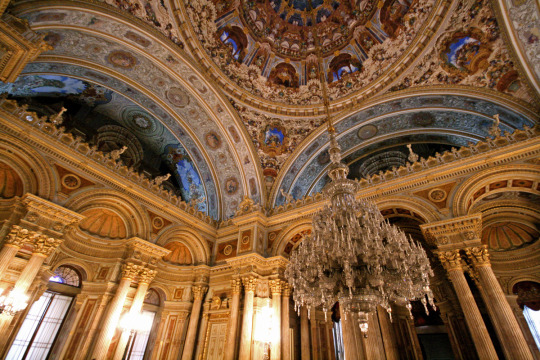
Ceremonial Hall
Dolmabahçe palace is not administered by the Ministry of Culture and is not a full museum, but is administered by Ministry of Palaces, because it is an amazing venue for hosting important summits and State dinners.
The highlight of Harem tour, that is after the palace tour, is the bed draped in National flag where the father of the Turkish Republic, Kemal Ataturk breathed his last. The clock by the table indicates his time of death. Every year, at 0905 on 10 Nov (Just 1 day after we left, because I did not know of this), the entire nation comes to a standstill in remembrance. Check out a link I have provided at the end and be amazed with the respect he commands. Also, it is recommended to read up about Ataturk, a fascinating figure in the 20th Century whose ideas about secularism in a 96% Sunni Muslim country that once held the keys to the Kaaba are at the same time inspiring and polarising and a bit of a cautionary tale about repercussions of imposing radical changes into a society.
Pro Tip: When I asked for Turkish Coffee with sugar, they gave me a small Lokum (Turkish Delight) with it. It was covered in powdered sugar, so foolishly I put it in, before realising my mistake. So, don't do that. The right way is to take a sip, then take a bite and so on. I had to fish it out with the stirrer. Fortunately, it was still very, very delicious.
Dolmabahçe is out and out a European palace, a far cry from spartan austerity that is the hallmark of Islamic teachings. It was so overwhelming that we did not possess any more mental strength to go see the painting halls consisting of the works of art commissioned by the Europe loving Sultans and many by the last Caliph, a patron of arts and a painter himself, Abdulmecid II. History buffs will be interested to know that this Caliph’s ousting prompted the Khilafat Movement in India during the WWI. We then headed to ‘check off one of my items on bucket list’, however cheesy and corny it might sound.
Kemal and Fusun
Orhan Pamuk is a divisive figure in Turkey. His Nobel win is touted by many as political, to force the hand of the state in the suit against him claiming he insulted the republic by recognising or hinting at Armenian Genocide. He is a somewhat liberal figure, not liked by nationalists in general. Mihriban, our hotel receptionist, guide and friend also stated that she disagrees with the politics of Pamuk, but seemed fascinated by the idea of the museum and wondered why she never went there.
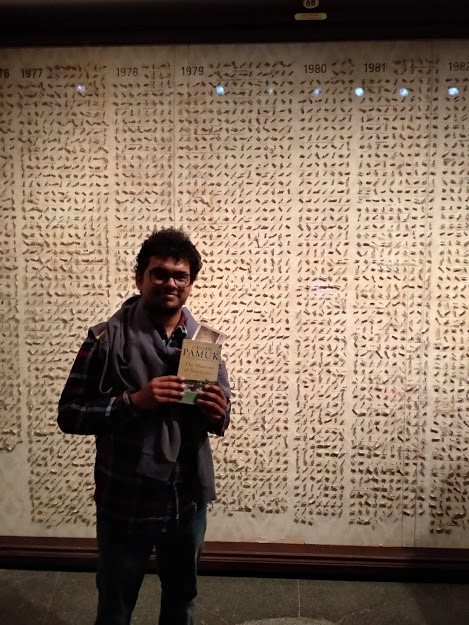
Me with each of the 4000 cigarettes that touched Fusun’s lips and had a mark of her lipstick to show for that. Pamuk’s protagonist is a melancholic, lovelorn, a a teeniest bit creepy (at least by today’s standards)
For people like me, borderline fanboys, we love his fascinating depiction of the mundane and his brilliant analysis and exposition of a nation struggling with its Westernising aspirations and traditions, and his exploration of a city that has a hankering for everything European and longing for the glorious days of the empire. My Name is Red and Istanbul: Memoirs of a City (that I read after coming back) are highly recommended.
Museum of Innocence is also a similar work where the protagonist who is somewhat like the author himself, belonging to the ‘society’ that shuns everything traditional and lives among the cocktail parties and fancy luncheons and everything else Western, falls for his cousin, a girl from a traditional Muslim family living in a crumbling middle class neighbourhood. Kemal has a bit of kleptomania which he likes to call his fascination with ordinary items, and everytime he visits Fusun’s house, he steals a small item from there. Eventually his collection grows so large that he makes a museum out of it, dedicated to Fusun. Orhan Pamuk made the exact museum with every item Kemal ‘stole’ in the book at the location where Fusun’s family ‘lived’. This fascinating concept of a museum complementing a book makes it a must visit if one admires Orhan Pamuk. What more, if you have the book, then your entry is without fee, and on a particular location in the book, there is a box where they stamp it. The book keeps referencing the museum and this stamped space is indeed a part of the story, making the book and museum complete in themself! Each chapter in the book has a shelf with exhibit dedicated so a Pro Tip: Buy an audio guide for only 5 TL. Each exhibit is explained by Orhan Pamuk and an actor essaying the role of Kemal (Yes, Orhan the author indeed makes an appearance in the book. As I said earlier, the book is complete in itself).
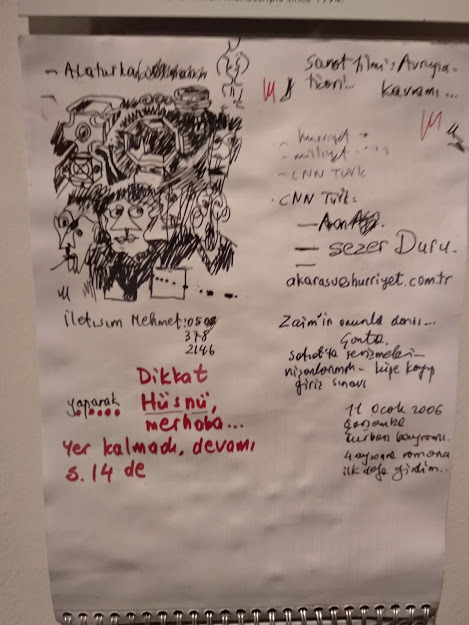
Pamuk’s scribbles
It is recommended that one visit the website of Museum of Innocence to check out Orhan Pamuk’s idea of a Museum.
The Most Instagrammable Neighborhood
Karaköy is probably called that because of its interesting graffitis, mesmerizing cobblestoned narrow alleys and the Galata Tower that rises from the middle. Travellers are forewarned that there will be a huge line at the Galata Tower in the peak season. But once you get on the top, you know why.
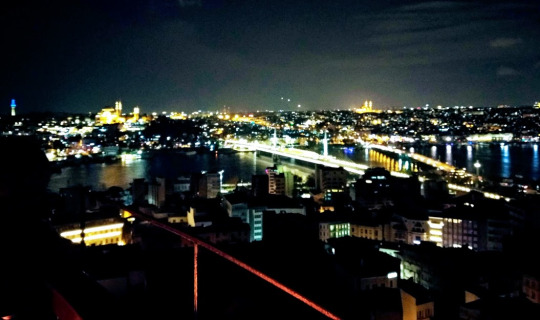
Galata Tower was built in the Genoese colony as a sentry tower and also as a tower to forewarn about any fire incidents in the city. So it is ironic that the tower itself fell victim to fire, and that is one amongst the umpteen times the tower has been damaged and rebuilt. It is now the primary fixture of the Golden Horn and the Istanbul skyline, and from the top, one can see all of Istanbul, from the Topkapı Palace, Ayasofya and Blue Mosque on one side to brightly illuminated 15 July Martyrs Bridge (formerly called Bosphorus bridge, renamed after the 2016 coup attempt) on the other. We climbed (rather, took an elevator) on top in the evening, in a crisp and beautiful weather, and then something fascinating happened: multiple Ottoman style mosques interspersed across the city start playing the Azan with remarkable synchronization. There are few experiences that are as unforgettable as this one, and this indeed is a quintessential Istanbul experience. It would have been nice to have a çay(chai) at this moment, but we took so much time to soak up the views of the strait and the streets (remember the FOMO anxiety we talked about in the palaces section?), that by the time we went inside to the restaurant at the top of the tower, it was closed.
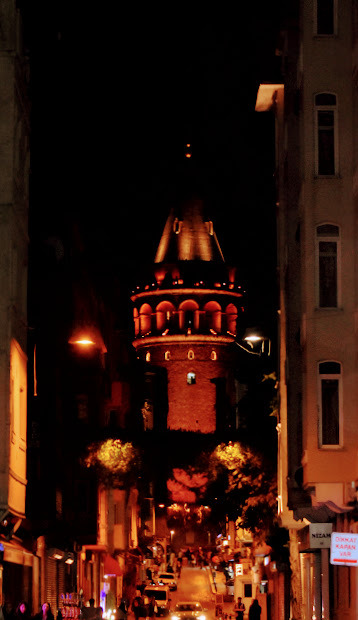
Galata Tower
There was a 4D Istanbul tour waiting for us downstairs on the 3rd floor though, which takes on this simulated helicopter ride across and inside the major landmarks in the city. It’s fun, despite of it sounding a bit pedestrian (I am talking about the population that finds things like these and roller coasters nothing more than gimmicky); go for it.

The other thing that one must do in Karaköy is simply walk around and soak up the sights and sounds. And eat a delicious, mouthwatering, big baklava at Karaköy Güllüoğlu for 25 TL. Syrupy, crispy, filled with pistachio nuts, one must definitely savour as much baklava as one can while in the city.

Mouthwatering Baklava at Karaköy Güllüoğlu
To Black Sea and beyond
No textbook Istanbul trip is complete without a ferry ride across/in the Bosphorus. Bosphorus, after all gives Istanbul ALL of its identity. Everything that the place is, it’s because of the strait. The strait joins Black Sea and Mediterranean Sea through the Sea of Marmara and The Aegean, making it all important and a prized possession. The location proved so strategic that more than a dozen sieges were attempted on the city, before Mehmed II actually achieved success. Thar is why the Greeks, the Romans, and the Ottomans wanted a piece of it, why Prophet declared that whoever conquers Konstantiniyye is the most blessed. The strait is a clear boundary between the great continents, and more importantly great cultures of Asia and Europe, of Orient and the Occident, and Istanbul is the meeting point, the city with the dual identity. The city is testament to the fact that much of human history, culture and language is all about geography.

Muhammad’s proclamation on the blessed conqueror of Constantinople (Place: Ayasofya)
So, Bosphorus Cruise. On Sultanahmet, many will try to sell you a cruise that will make a trip of the strait, the golden horn, will have a buffet, all for €20. Or there is the famous Big Bus Istanbul tour where they will take you to an all day tour of all the Istanbul places and a cruise for €30 or 60. You can go for the latter if you are on a layover trip. You can ignore the former; never too good an idea to go with the touts. You can get all the information about a cruise with food and entertainment for €20-60 from the front desk of your hotel, a very good reliable source of information, and even better if you have a rapport with the receptionist.
Or you can rough it out (not really) and make use of one of the most bang for bucks public transport service (details of Istanbul public transport network will have a dedicated section; don’t worry): Şehir Hatları.
Şehir Hatları is the City run ferry service that, apart from its regular services to and fro the opposite banks of the bosphorus, also runs a 6 hour cruise all for, drumroll please, 25TL! There is one cruise per day and it picks you up from the Eminönü docks at 1000 hrs all the way over to the village of Anadolu-Kavagi near the Black Sea and brings you back by 1630.
The cruise itself was sparsely occupied, probably due to tourist season ending. Which is a boon because in peak season, the cruise gets full pretty quickly. Waiting on Eminönü docks for our ticket we met this guy who had a giant parrot on his shoulder, the size of which freaked out Soumya. He placed the parrot on Soumya’s shoulder and offered that we click a photograph for 15TL I think. We politely refused, so here’s a stock photo.
The ship had 3 floors, with lower deck having cushioned benches and table a la a classic American diner, with a small stall serving snacks. The mid and top deck were outside, and if you can tolerate the cold, cold breeze, you will see sights unparalleled. As Hagia Sophia, Blue Mosque, Suleymaniye mosque, and Galata Tower to your right seem to get farther and farther away, you get to see the iconic Istanbul skyline which I can never get used to. The first stop is Üsküdar on the Asian side. This neighborhood, considered a bit conservative as opposed to the more liberal and open European side, is famous for its sunset views, which we missed by a few minutes on our last day, but still enjoyed çay along the banks, where many had set up cushions for tourists and lovebirds to enjoy with Bosphorus views.

As we approach Karaköy, the view is dominated by the imposing Dolmabahçe palace. Along the way you pass 2 of the three bridges that connect Europe to Asia, numerous Bosphorus mansions called Yalis and the castles of Rumelihisari and Anadoluhisari. I did not know at that time, but Rumelihisari or Roman Castle was built by Mehmed II as a sister castle to Anadoluhisari which was on the opposite banks, and together acted as a throat or strait cutter, cutting off the rest of the city before laying siege. Other notable sight were those of gargantuan cargo vessels that sailed by and the seagulls that competed with our cruise, making use of wind currents to float and making loud noises. You will always find these noisy creatures chasing a ship, probably for food, and the Bosphorus is filled with these seagulls; they are what pigeons are to our cities: a regular feature that are sometimes just pest.

Bosphorus Panorama
Our last stop in the onward journey is the tiny fishing village of Anadolu Kavagi, which is directly opposite to the penultimate Rumeli Kavagi. The word Rum is used to denote Roman Anatolia or simply Roman or Rome. The Ottoman Padishah used to have the title of ‘Kayser-i-Rum’, the descendant of the Romans, and omission of this title in diplomatic communication was casus belli, or cause of war. The famed Sufi saint and poet Jalal ad-Din Muhammad has the title ‘Rumi’ attached to him because of his place of operation, in the Anatolian heartland., specifically Konya, an overnight journey from Istanbul by road. Although he is also known by the name Balkhi, placing his origin at Balkh in what is now Afghanistan.

Seafood at AK. Most good restaurants serve a basket of bread by default, a complementary feature. Water, you gotta buy separately.
At the AK, you have a stoppage of 2.5 hours to feast over some delicious seafood (yours truly refrains from meat and prefers to enjoy it vicariously) and visit the Yoros Castle, an outpost built by the Thrace as a strategic watchtower. The village is now occupied by the fishing community and the Turkish Armed Forces. Once you start walking around searching for a place to eat, as in any other Istanbul tourist area like Sultanahmet,the restaurant maitre-d’s (if they can be called that) start to cajole you for your patronage. We chose a seafood place with nice Bosphorus view, and as recommended by the immaculately dressed waiter, ordered a fish and something vegetarian that you don’t care for anyway (although there are good vegetarian options in Turkey). And we ordered Rakı .
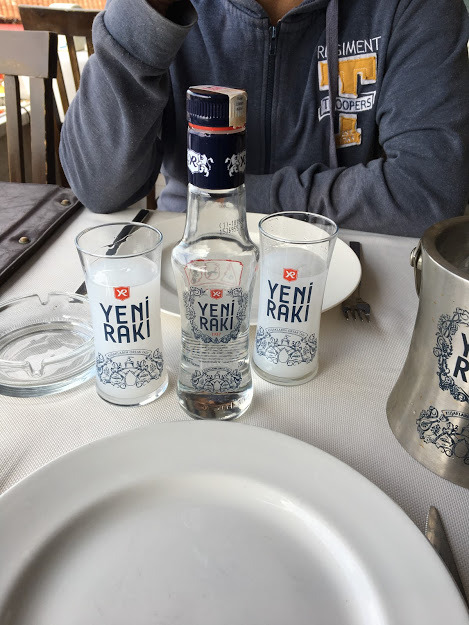
Rakı
Rakı is Turkey’s national alcoholic beverage made from rice and has a strong anise or saunf taste. One dilutes the Rakı with water and it turns white from colorless! Soumya exclaimed that it looks like a local beverage popular in Orissa called Handiya.
And it gets you drunk fairly quickly, leaving you in a happy merry kind of stupor that fortunately or unfortunately dissipates within an hour. We were laughing uncontrollably, consuming the lunch extra slowly and by the time we sobered and paid up, we had already spent an hour and a half in the restaurant. Which maybe commonplace in Europe but for the Indians, almost unheard of!
This left us just about half hour to climb up the hill and visit the Yoros castle (fully sober by then, by the way). The castle itself lies in ruins, but the views of deep blue strait that merges into the Black Sea, and the beautiful Yavuz Sultan Selim bridge that straddles the waters gave us the aforementioned FOMO as the time was running out and we would be in trouble if we missed the ferry.

The hastily clicked Yavuz Sultan Selim Bridge. The water body beyond is Black Sea!
The return was mostly spent in soaking up the scenery and staring at the seagulls.
The Ice Cream Trick
Dondurma is the Turkish ice cream made of a resinous substance that allows it to stick to a surface and defy gravity. This enables the ice cream guys to perform that trick where they pretend to give you the ice cream but snatch it away, drop it but really it sticks to the big handle, do this 3-4 times before handing the ice cream over.
So then, at Taksim Square where we are being entertained by this ice cream cum performance I told Soumya in hindi that let’s play the same trick and give him money but take it back. The guy sort of read our mind and pointed at a spot in the table saying ‘Put it here. I have been doing this a long time.’ Ah damn!
Another performance with food we saw was at a Kebab place in Sultanahmet where I ordered a vegetable hot pot, which they served with a sticky rice. They filled the earthen pot with the veggies like mushrooms and put it up on a small stove of smoldering coal, brought it to us and did a little performance before hitting the top of the pot, and off went that piece of pot flying. You will see this trick being performed in many restaurants in Sultanahmet.
Touristy things are fun, who knew.
Find the link to a Dondurma trick at the end. Keep searching for more, fun way to waste more time on YouTube.
Pro Tip: For the vegetarians out there, plenty of mediterranean salads like abaganoush are available in almost all restaurants. Or do what I did in a small restaurant near Cemberlitas: Ordered a chicken roll without the chicken!
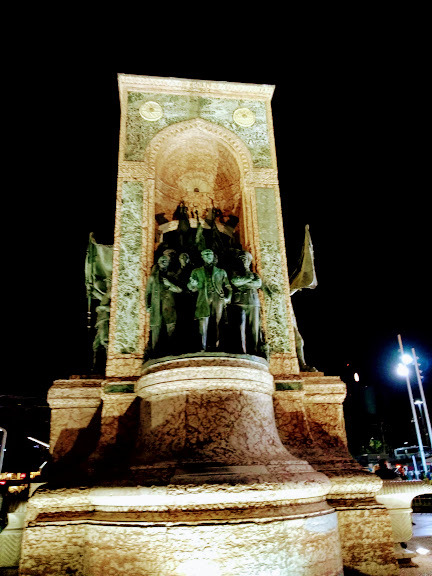
The monument to the Republic at Taksim Square. The gentleman at the front it Mustafa Kemal Ataturk.
So we boasted (or opposite of it) to Mihriban that whatever crowd she thinks we will encounter at Taksim, it can never be as bad as India, because well we are the crowded country, aren’t we? We were proven so wrong at the historical Istiklal Caddesi or Istiklal Avenue near Taksim. Generally we did not find Istanbul crowded, but that may be attributed to the end of peak tourist season. But the crowd at Istiklal Street on a weekday was comparable to the crowd at, say, Connaught Place or Chandni Chowk! The street is lined with Ottoman era buildings (European style, so perhaps late Ottoman, when European influence became marked), shops, restaurants of all kinds-doner kebabs to your KFCs and Burger Kings, intriguing street performances here and there, and the classic Taksim- Tünel tram line. While the trams running in Istanbul, used for commuting, are all fast and modern built by Alstom, the Taksim- Tünel line has been kept mainly as an attraction, the slow old trams of the olden days. There is just one coach that does the up and down from Taksim to Tünel, and it is crowded by tourists who want the touristy experience of the Old Istanbul. We decided to skip that and just walk the whole way, from Taksim to Tünel and beyond. At Tünel, you have the Funicular line, which is essentially 2 coaches on a long looped rope and pulley mechanism such that when one coach goes up the other goes down. Mainly used to go up and down a sloping, hilly area.
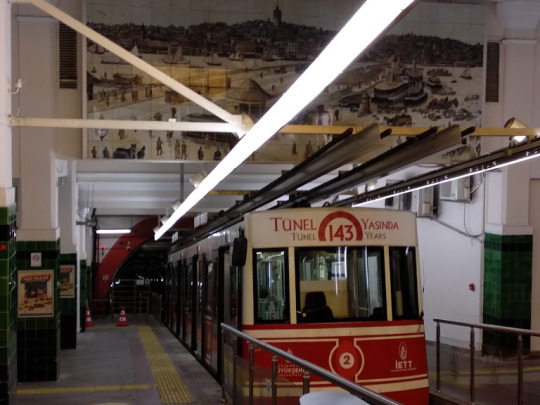
Historical Funicular at Tünel
There are streets that branch out of Istiklal with interesting restaurants, all having a musical performer to entertain their guests. Unfortunately the restaurants are so close that you can here 3-4 guys singing loudly at the same time, resulting in utter cacophony!
We managed to find a vegan Lebanese restaurant in the street, and had delicious falafels there.
The People We Met
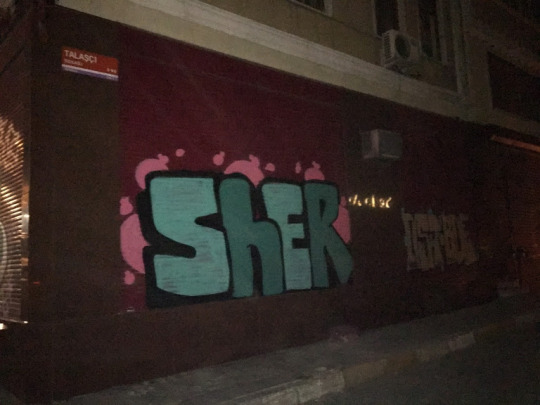
Graffiti we encountered on a walk in Beyoğlu
One important component of travel to a place is the people one encounters or meets. While I myself have difficulty in opening up to strangers, it helps if I have a slightly more outgoing companion or a person easy to talk to.
Which is where Mihriban, our 30 something Kurdish friend from Ankara who has a degree in Turkish Literature, likes fitness and does not like Orhan Pamuk, and has a disarming style and persona comes into picture. She also very kindly took us to Suleymaniye Mosque, shop at Mahmut Pasha and the nearby more famous grand bazaar, and a rooftop coffee with lokum with views of Golden Horn and Bosphorus, which the reader may tire of but I most certainly did not.

Turkish Coffee at a rooftop joint
One stop at Mahmut Pasha we took was to buy some Shawls, beautiful silk ones which I later learnt were called stoles. I realised that I was bad at picking clothes for women when Mihriban pooh-poohed almost all of my choices (Thank God). After shopping for a good 8-9 stoles between the two of us, the shopkeeper decided to offer us some çay (tea), instead of giving us further discounts. In a typical Indian manner, we finished the tea while Mihriban had not even reached the halfway mark. This led shopkeeper to exclaim in surprise that we finished it off way to quickly, and Mihriban interjected that we must savour things more deliberately.
From the crowded Mahmut Pasha,filled with vendors selling all the varieties of lokum possible, we moved to the Grand bazaar, another quintessential Istanbul attraction with vendors selling everything from lamps to carpets to tiles to lokum to spices-you know, your typical Oriental market, only way expensive. We did get our hands on some beautiful Iznik tile coasters at Iznik Works in Grand Bazaar. The Iznik form of ceramic pottery originated from the Iznik towns and was very much in demand by Ottomans to decorate their palaces and mosques. Be it Topkapı Palace, Suleymaniye Mosque or Blue Mosque, you will find these tiles adorned as mosaics everywhere.
For some reason, we decided to lunch at the Burger King at Cemberlitas, and I had the one vegetarian option available on the menu- a bean burger. It was yum.
ProTip: There are types of Lokums that I gather are available. One is a slightly cheaper one that resembles those dense gelatinous halva we have in India. The other types are more expensive (100TL for a kg) that are filled with variety of nuts and have richer flavour diversity. Buy them either from franchise stores like Mado or Hafiz Mustafa or explore on your own, in Sultanahmet, Mahmut Pasha, Grand Bazaar, or that bazaar near Blue Mosque. Also eat tons of Baklava, an advice worth repeating.
ProTip: Much to my frustration, during a bit of googling for this piece, I discovered that Zomato operates in Istanbul! What! And oh, by the way, Wikipedia is banned in Turkey. This I discovered only when I returned. That’s why I was not able to open there.
Mihriban also used to make çay for us in the evening when we had returned from our trips, and we would discuss about religion, cultures, exercise, family, living in Istanbul, and how Istanbul is the number one destination for bald Arab men to get hair plugs (You see a lot of bald men with bleeding head or head covered with cotton) and so on. Mihriban’s demeanor brought in many friendly guests of the hotel, and one such was a wise old man from London called Abu Bakr John, who came with his wife Hatija. Abu-Bakr was a Mauritian immigrant to London, and had a little bit understanding, at least an inkling of Hindi, because obviously his forefathers were from India. His wife Hatija adored Shah Rukh Khan, just like Mihriban adored Aamir Khan. Mihriban claims to have seen all of his movies and to prove her claim, she referenced the giant colorful ass-chairs the three protagonists of ‘3 Idiots’ sat on. Then we proceeded to talk about the latest bollywood film she watched, ‘Padman’, and I showed her the TED talk of the actual Padman, Arunachalam Muruganantham, on Youtube with Turkish subtitles, which she found pretty delightful.
We also talked about the Turkish TV viewing habits, and how Turkish people prefer watching Indian soaps over local fares, which is more popular in Azerbaijan (Azeris watch Turkish soaps, Turkish watch Indian series, Indians watch American series and Americans just watch their own!) Also, Mihriban, and by her I guess most of the Turkish TV viewers, think that the streets on India is filled with cows, the cows that we worship, which she found amusing. I can’t say I don’t agree with that stereotype.
We also tried to chat with a bunch of Moroccan ladies from Brussels in the lobby. The trouble was that they knew only French and Mihriban had to use Google translate for the simplest of the things. We were also talking about Muslim marriages and the concept of Mehr when the Belgian lady asked whether we were Muslims. I said no. We tried telling her, probably through google Translate that we were from India and we were Hindus, and she just replied “Buddhists?” We nodded and just left it like that. While retiring for the night, we were talking about how difficult French was and I tried to pronounce ‘Au revoir’ as O-re-vwa. One of the Belgian ladies heard us and said what I thought was ‘Au wa’. The guttural r is simply not an Indian thing.
Transportation
This is a Protip chapter. Much to the annoyance of many, I have a love for efficient public transport. And Istanbul’s has one USP: Integration. From Ataturk Airport, if you have to go to say Üsküdar, you can take a taxi that will drive you all the way to one of the Bosphorus bridges and drop you there, and charge a bomb. Airport transport from our hotel, which is on the European side, same as Airport, takes €60, which is astronomical. The cheaper and more pleasurable way is to take a metro from the airport, change at Zeytinburnu or Yenikapi to the tram, take the tram to Eminönü Tram station, cross the road to the Ferry station and hop on to one of the Şehir Hatları cruise. And it is fast with no hassle. Metro has a frequency of 10 min, tram of 2 and boats of 30, and purchasing an Istanbulkart at an automated dispensing machine at every bus, tram or ferry station, which is just 6TL, and rides that are equally nominal means you have covered 20+ km journey in 15-20TL! The transport system that connects the massive city integrates Metro, Bus service, Tram, Funicular, Ferry, and an undersea train service called Marmaray (which we unfortunately did not try).

Istanbul Transportation Map. Zoom/open separately for clearer view.
The Alstom built trams are ridiculously fast and modern, except the antique one at Taksim. Therefore, be careful when you cross the roads.
TLDR
Hotel: Best place to get a hotel if you are in Istanbul for the first time and if you want to visit all the sites is of course the Sultanahmet area in Fatih district, as major old city attractions are all within walking distance, there is a seaside promenade nearby for sunrise/sunset strolls/jogs, and lot to eat! We booked at Harmony Hotel Istanbul, a cozy hotel with free executive breakfast, a spacious balcony and lounge with great sea view if you get top floor.
Tipping: Something Indians are not too attuned it, but is expected outside. We stuck with the 10%-20% almost across the board (towards the lower side of that range we must admit.) Most places have a tip box where you can contribute.
ATM & Currency: International Debit Cards are accepted almost in all ATMs. Withdraw from ATMs of known international banks or Turkish banks like AKBank or DenizBank. Remember, they all charge 3% conversion charge. Currency can be exchanged at the AKbank counter in the Arrivals of Ataturk airport, or at many exchange (Doviz in Turkish) centres in Sultanahmet, Grand Bazaar or Taksim. We exchange the €50 we had saved for the end of the trip at Ağaoğlu Döviz near Cemberlitas tram stop.
Sultanahmet Area: From Ataturk airport, catch a metro, change to tram at Zeytinburnu or Yenikapi going to Kabatas, get down at Sultanahmet stop. Walk around, it is amazing. See hippodrome with obelisk from Egypt (That was day 0).
Day 1:
Ayasofya or Hagia Sophia: 3 Hrs, 135 TL for combined Ayasofya, Topkapı and Archeology Museum Ticket. (Closed Mondays)
Blue Mosque: Free Entry, but do check out the timings.
Hamam: Turkish bath at Gedikpasa Hamam for 120 TL. Rejuvenating. Pickup from and drop to included in most packages. Contact front desk of your hotel.
Day 2:
Topkapı Palace: Separate tickets for Harem, but worth it. Get an audio guide. (Closed Tuesdays)
Gulhane Park: A park near Topkapı, beautiful, lush and has a mosque within for a prayer.
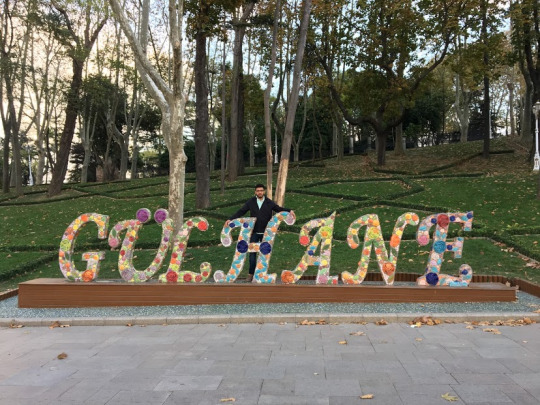
Day 3:
Istanbul Archeology Museum (Closed Mondays): For history buffs. Artefacts from Mesopotamia, Sumeria, Hittite, Phoenicia, Greeks and Romans.
Dolmabahçe Palace [Location: Karaköy]: Reach by tram from Sultanahmet, get down at Kabatas. Tickets to Palace + Harem is 90 TL. Audio guide is free and is also available in Hindi. Attractions are the European style grandeur, and the resting place of Mustafa Kemal Ataturk. There is an upper limit on number of people allowed, so go as early as possible especially in peak season. Also, no photography inside.
Museum of Innocence: Get down at Tophane Tram station, walk up a hill few hundred meters till you find a small house with vertical banner proclaiming itself as The Museum of Innocence. 40 TL if you don’t have the book, open till 6 (Closed Mondays). Guides available at 5TL with voiceover of the man himself.
Karaköy Güllüoğlu: Get down at Karaköy station and walk. Get a big baklava for 25TL.
Galata Tower: Walkable from Karaköy station. Keep walking towards that tower with the conical top. Roam around in the Karaköy neighbourhood. Expect a line at the Galata. The view is worth it. Also get the 4D ride at 13TL. It’s down at the 2nd floor though.
Day 4:
The Bosphorus Cruise: Starts at 10 AM from Eminönü docks, goes all the way to Anadolu Kavagi and back. Visit for the beautiful Cruise views, seafood and Yoros castle.
Day 5:
Suleymaniye Mosque: Walkable from Sultanahmet, or catch a tram to Bayezit. Sublime. Free reading materials on Islam for those interested.
Shopping at Mahmutpasa and Grand Bazaar: Shawl, lokums, carpets, tiles, lamps etc.
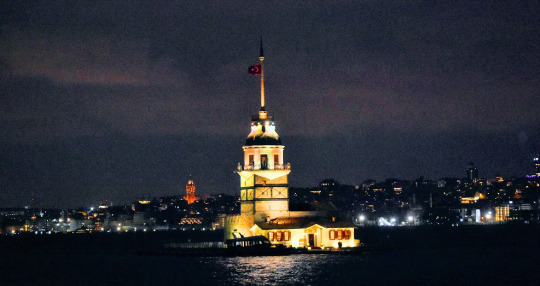
Maiden Tower or Kız Kulesi, taken from the Asian side. Galata Tower in the European side seen in background
Üsküdar and Kız Kulesi: Ferry from Eminönü . Visit for beautiful sunset if there are no clouds. Sip a çay as you enjoy the Bosphorus views. Kız Kulesi or Maiden Tower is not worth it.
Day 6:
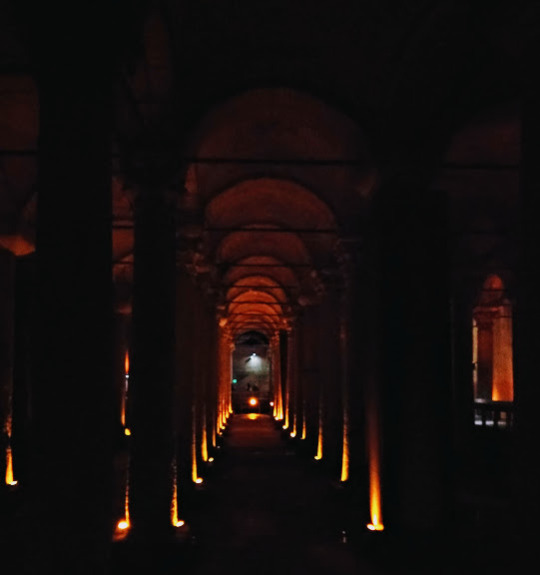
Basilica Cistern: In the Sultanahmet area, walkeable. Beautifully lit underground water reservoir dating to the Roman Empire. Visit for Roman architecture and columns with Medusa heads on it.
youtube
Commemorating Ataturk.
youtube
The Dondurma trick
0 notes
Text

MARBLE IN INDIA
BY D.C BHANDARI
CEO
BHANDARI MARBLE GROUP
SINCE 1631
INDIAN MARBLE
BHANDARI MARBLE
We are a top leading Indian Marble Manufacturers, Exporters, Supplier based in Kishangarh Rajasthan India and Wholesale Suppliers of different types of colour Indian Marbles & the high quality & highly demanding Indian Green Marble, Makrana White Marble, Indian Onyx Marble and Marble Stone. BHANDARI MARBLE are suppliers of Indian Marble in all over World: USA, UK, UAE, INDIA, SINGAPORE, HONG KONG, SHRI LANKA, DUBAI, FRANCE, AUSTRALIA, NEWZILAND, Bangalore, Delhi, Kolkata, Mumbai, Hyderabad, Chanai, Pune, Jaipur, Ahmedabad, jammu, Ludhiana, Jalandhar, Pathankot, Punjab, Simla, Hamirpur, Himachal pardesh, Chandigarh, Panchkula, Mohali, Sirsa, Gurugram, Hariyana, Delhi, Noyada, Delhi NCR, Kanpur, Agara, Lucknow, Uttar Pradesh, Patna, Bihar, Bhuwneswar, Katak, Urisa, Siliguri, Kolkatta, Hawara, West bangal, Gohati, Asam, Kathmandu, Virat nagar, Nepal, Sikkim, Hyderabad, Vishakhapattnam, Vijaywara, Andhra pardesh, Telangana, Banglore, Manglore, Masore, Hubli, Karnataka, Chanai, Erode, Salem, Trichi, Madurai, Coimbatore, Tamilnadu, Kochi, kolam, kalikat, Kanoor, Kaghikode, Kerala, Goa, Pandichery, Belgaon, Mumbai, Navi Mumbai, Pune, Jalgoan, Jalana, Nagpur, Maharastra, Bhopal , Ujjain, Indore, Madhay pardesh, Surat, Ahemdabad, Rajkot, Gujrat, Jaipur, Jodhpur, Udaipur, Kishangarh, Makrana, Ajmer, Bharatpur, Rajasthan and other Cities.
Bhandari Marble World is one of the largest Manufacturers, Suppliers and Exporters of Marble, White marble, Latin marble, Slabs, Floor Tiles, Blocks, Green Marble Slabs, Tiles, Rainforest Green Marble Slabs, Tiles, Marble Counter Top and Marble Stone.
If you are in looking of Indian Marble, Green Marble, Forest Green Marble, Indian Onyx Marble, Green Onyx Marble, Makrana Marble, White Marble, Kishangarh Marble, Morwad Marble, Katni Marble. Please get in touch for the best quality marble, color, varieties and drop us an email with your requirements for affordable Indian Marble Prices.
We are supplying our Indian Granite to Delhi, Bangalore, Mumbai, Kolkata etc
Indian Marble Image
www.bhandarimarblegroup.com/showroom/
Or
www.bhandarimarblegroup.com/ebook/
Indian vs Italian Marble: What Works Best For Your Home?
No doubt INDIAN MARBLE
When it comes to marble, you have two options that are immensely popular in Indian homes. Both Indian marble and Italian marble are amazing choices for your flooring or surface top needs. But how do you pick the right marble that’s INDIAN MARBLE perfect for your home and budget?
While there’s a lot of info out there and it’s easy to get overwhelmed, here are the basic differences you need to know between Indian and Italian marble.
INDIAN MARBLE,
BHANDARI MARBLE GROUP
Indian marble is quarried extensively in North India. This makes it a cost-effective choice with a wide variety of colors and textures.
INDIAN MARBLE
BHANDARI MARBLE GROUP
On the other hand, Italian marble is quarried in Italy and is now easily available in India as well. It is widely appreciated for its high lustre and imparting visual appeal to the area where it’s used.
ITALIAN MARBLE
BHANDARI MARBLE GROUP
Popular Types of Indian and Italian Marbles
BHANDARI MARBLE GROUP
Indian marble: It comes in an astonishing array of colors such as white, pink, yellow, green, red and black. Some of the popular varieties include:
INDIAN MARBLE
BHANDARI MARBLE GROUP
white Makrana marble (famously used in the Taj Mahal)
MAKRANA MARBLE
BHANDARI MARBLE GROUP
High-quality white Ambaji marble from Gujarat
AMBAJI MARBLE
BHANDARI MARBLE GROUP
The widely exported Indian green marble
GREEN MARBLE
BHANDARI MARBLE GROUP
Onyx marble which gets its name from the thick bands of alternating color
ONYX MARBLE
BHANDARI MARBLE GROUP
Italian marble: Like its Indian counterpart, this comes in a variety of color and textures. Though there are a few varieties which are instantly recognizable, such as:
ITALIAN MARBLE
BHANDARI MARBLE GROUP
The much valued Statuario marble which is characterised by its white color shot with grey or gold veins
STATUARIO MARBLE
BHANDARI MARBLE GROUP
Golden hued Botticino marble which seems to be l
from within
BOTTICINO MARBLE
BHANDARI MARBLE GROUP
Light grey Carrera marble which features dispersed, fine, feathery veining
CARRARA MARBLE
BHANDARI MARBLE GROUP
MARBLE PRICE
Indian marble: While the cost of marble varies from city to city and vendor to vendor, Indian marble starts from as low as ₹30 per sq ft for some varieties of Indian green marble. It goes up to ₹150 per sq ft for other varieties.
INDIAN MARBLE PRICE
BHANDARI MARBLE GROUP
Italian marble: Since this is available in a wide variety, prices could range from ₹150 to ₹5,00 per sq ft, and sometimes more.
ITALIAN MARBLE PRICE
BHANDARI MARBLE GROUP
MARBLE FITTING COST
BHANDARI MARBLE GROUP
The cost of laying both Indian and Italian marble are different in price, Indian marble which is between 20 to ₹50 per sq ft. Italian marble 75 to 150 RS per sq feet & Laying marble involves creating a base of cement and river sand.
Monuments made up of White Marble from India..
BY BHANDARI MARBLE GROUP
There are many monuments that are made up of White Marble India they are like:
The TajMahal
BHANDARI MARBLE GROUP
The TajMahal, that is fully made up of white Indian marble, TajMahal is located in Agra, and made by a Mughal Emperor Shahjahan in the memory of his beloved wife. The TajMahal is one of the seven wonders of the world. The TajMahal means “CROWN OF PALACES” according to Persians and Arabics, Its garden has lot of trees and fountains, The other one is:
The Lake Palace
BHANDARI MARBLE GROUP
The Lake Palace, formerly known as Jag-Nivas, it’s a luxury hotel in Udaipur, Rajasthan, India. it is made up of Indian White Marble, and it is located on a natural foundation of 4 acres (16,000 sq mt.) on the Jag-Nivas island in lake Pichola Udaipur India. It was built in 1743 in the supervision of Maharana Jagat Singh 2. and was called Jag-Niwas after its founder, the successive Ruler used this place is as their summer resort holding their Darbar in its cortyart with columns terraces fountains and gardens. and another one is:
BHANDARI MARBLE GROUP
KILA OF
Jaipur, Jodhpur, Bikaner and other places in Rajasthan.
BHANDARI MARBLE GROUP
To know more about Indian White Marble please visit
www .bhandarimarblegroup.com
white marble
Gold Marble
Katni "Marble
BHANDARI MARBLE GROUP
White wonder Marble:
BHANDARI MARBLE GROUP
Lady onyx Marble
BHANDARI MARBLE GROUP
Makran white marble
BHANDARI MARBLE GROUP
Jaisalmer Gold marble
BHANDARI MARBLE GROUP
Kishangarh White marble
BHANDARI MARBLE GROUP
Marble Products
BHANDARI MARBLE GROUP
Sandstones
0 notes
Link
India's largest artificial marble tiles exporters, manufacturers & suppliers in Ahmedabad, India, Russia, South Korea, Thailand, Poland, USA, Vietnam, and Germany. A ONE in all pet bottle mould Get contact details of themillenniumtiles
#artificial marble tiles#artificial marble tiles manufacturers#artificial marble tiles manufacturers in Ahmedabad#Gujarat double loaded vitrified tiles#italian slim tiles#600 x 600mm non digital floor tiles
0 notes